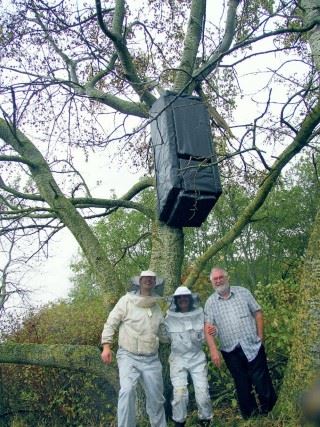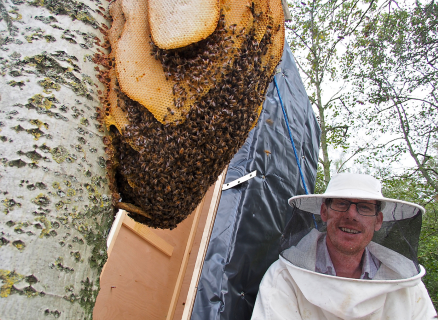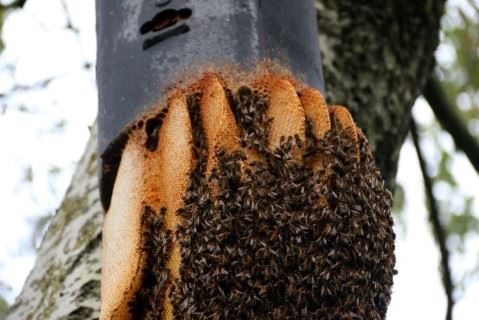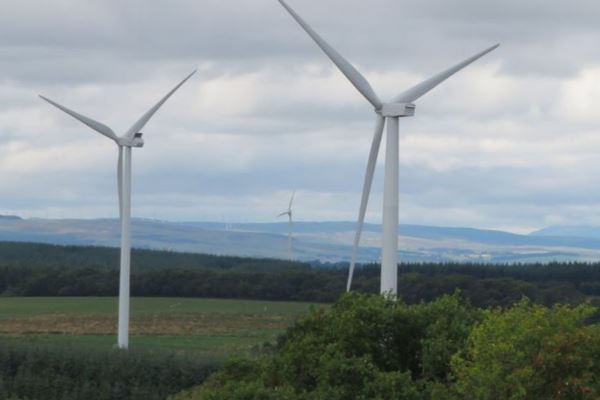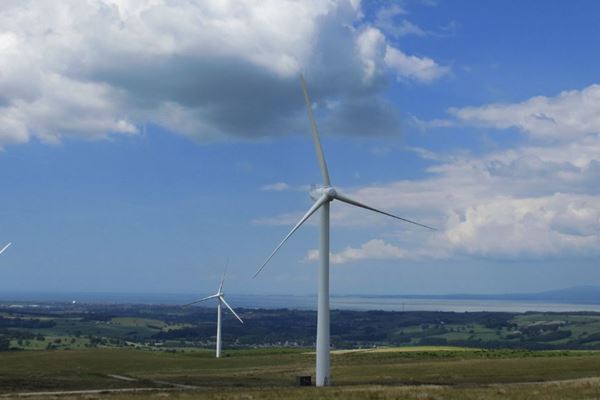The discovery was made during Thrive's wind farm open day in September which saw over 300 visitors and families gather to learn more about renewable energy and see wind turbines up close.
The day took an unusual turn when one visitor asked: ‘What’s that strange thing outside on the tree?’
Luckily, local ecologist Bernice Roberts, of the Landmark Practice, was on hand to advise. To their amazement they discovered a huge natural ‘honeycomb’ beehive spilling out of a bat box attached to a tree.
“The colony has extended below the bat box by some 500mm, comprising five or six substantial combs, which appeared to have anchored very firmly to the supporting tree. If left, the colony could very well die in damp and cold weather but, given the size and anchoring to the tree, it could not be moved to a suitable hive.” Bernice Roberts said.
In perfect timing, Bernice discovered, to her surprise, that the face painter at the open day was a local bee enthusiast who put her in touch with local natural beehive co-ordinators, Sal Pearson and Roger Wood.
It was a race against the clock to save the beehive as the weather had taken a turn for the worst.
Sal Pearson explained:” It’s unusual for honeybees to nest in such exposed positions but when they lack any alternatives, such as rotten tree trunks and spaces big enough for them to consider setting up home, they will make their home where they can.
“Since we had a dry spring, it was certainly an option surviving in the open.
“But damp will kill a colony faster than the cold and since the weather had turned wet and windy rapidly over that particular weekend, it was clear that some form of protection would be needed to give them a fighting chance to survive the winter.” She said.
Mark Doughty, Principle Ecologist at Wessex Water, landowners of the site, co-ordinated saving the bees. It all worked out well as Mark has been connected to bees all his life, his father is a veteran beekeeper. He naturally stepped in to help save the colony.
“It was just amazing to see the galleries of honeycomb all formed up with the hive in its natural state, I’ve not seen anything like it. Usually we see man-made hives, but this natural beehive is fantastic to see and encouraging that wild bees are rewilding.” Said Mark Doughty.
Mark Doughty acted quickly helping Sal Pearson and Roger Wood to get the casing up and around the bees just a couple of days after the open day.
“We had to get the structure up the tree and over the beehive. We put some scaffold in place under the hive, hauled it up, then took a break and the bees were placid all the way through. Hives can have a character all of their own and can be unpredictable, yet the honey bees let us work around them quite happily.
“We didn’t use any measures to pacify them, no smoker or anything, we just worked quietly and calmly. You can be sure they’ll let you know if they’re unhappy!
“A bucket of cow dung from the back of Sal’s car and straw was used to make a wadding and fill the gaps. We started trowling dung over the top and covered it all with a natural cement. It’s a substance the bees won’t reject and will accept. The case is now strapped to the tree. We came back couple of days later and could see the bees have access from behind.” Said Mark Doughty.
Matthew Clayton, MD of Thrive Renewables, sustainable investment company and owner of the wind turbines said: “It was surprising to find the honey-bee hive on the site. We operate renewables projects all over the UK, many on industrial sites, but none have been quite so interesting from an ecological perspective.
“When we first built the four turbines, which are spread across the waste water treatment works, and now a nature area, we had a number of measures put in place to protect and safeguard the great crested newts that were already there. We discovered in 2016 nesting barn owls and it’s now our second year to have them breeding on site.
“Seeing the incredible natural honey beehive demonstrates the site is providing a safe and natural haven for protected species. Sustainability is core to our values, and is a key motivator for people to invest in us.”
The wind farm offers a natural haven for wild honeybees.
The whole team are delighted to know the wild honeybees are safe for winter and very much hope they’ll decide to stay and set up home in one of the new natural beehives that are looking to be put around the wind farm over the coming months.
Amazing Facts about Honey Bees
- Bees are the only insect that produces food eaten by man.
- Honey is the only food that includes all the substances necessary to sustain life, including enzymes, vitamins, minerals, and water; and it's the only food that contains "pinocembrin", an antioxidant associated with improved brain functioning.
- Their exceptional olfactory abilities include kin recognition signals, social communication within the hive, and odor recognition for finding food.
- Their sense of smell is so precise that it could differentiate hundreds of different floral varieties and tell whether a flower carried pollen or nectar from metres away.
- A hive of bees will fly 90,000 miles, the equivalent of three orbits around the earth to collect 1 kg of honey.
- A honey bee visits 50 to 100 flowers during a collection trip.
- A colony of bees consists of 20,000-60,000 honeybees and one queen. Worker honey bees are female, live for about 6 weeks and do all the work.
More amazing facts here at benefits-of-honey.com
